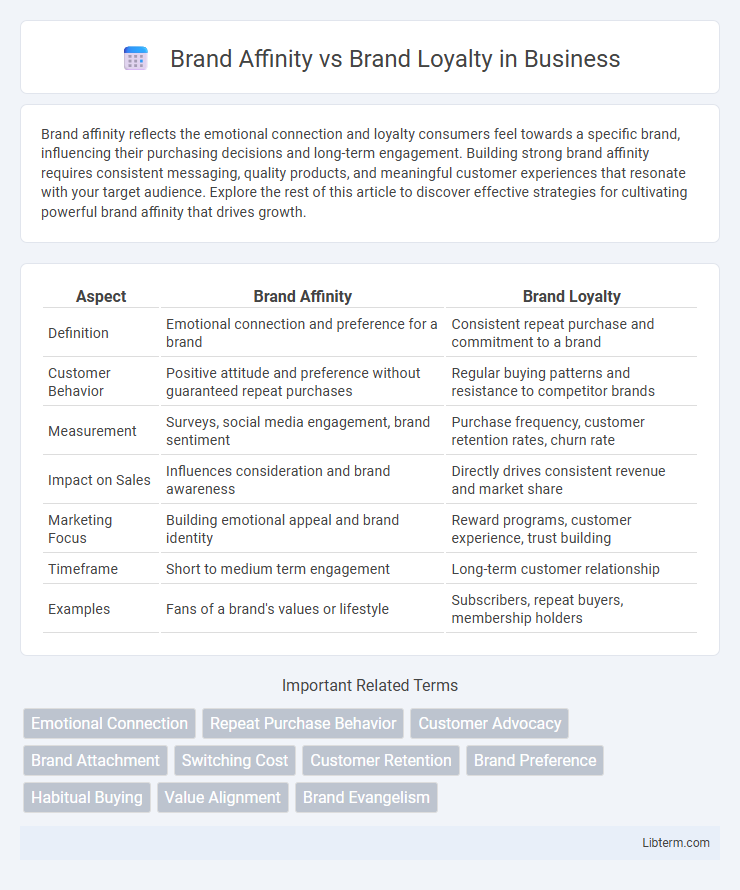Brand affinity reflects the emotional connection and loyalty consumers feel towards a specific brand, influencing their purchasing decisions and long-term engagement. Building strong brand affinity requires consistent messaging, quality products, and meaningful customer experiences that resonate with your target audience. Explore the rest of this article to discover effective strategies for cultivating powerful brand affinity that drives growth.
Table of Comparison
| Aspect | Brand Affinity | Brand Loyalty |
|---|---|---|
| Definition | Emotional connection and preference for a brand | Consistent repeat purchase and commitment to a brand |
| Customer Behavior | Positive attitude and preference without guaranteed repeat purchases | Regular buying patterns and resistance to competitor brands |
| Measurement | Surveys, social media engagement, brand sentiment | Purchase frequency, customer retention rates, churn rate |
| Impact on Sales | Influences consideration and brand awareness | Directly drives consistent revenue and market share |
| Marketing Focus | Building emotional appeal and brand identity | Reward programs, customer experience, trust building |
| Timeframe | Short to medium term engagement | Long-term customer relationship |
| Examples | Fans of a brand's values or lifestyle | Subscribers, repeat buyers, membership holders |
Understanding Brand Affinity: Definition and Key Traits
Brand affinity refers to the emotional connection and positive attitude consumers hold towards a brand, influenced by shared values, experiences, or identity alignment. Key traits of brand affinity include trust, perceived quality, and emotional resonance, which drive preference without requiring repeated purchases. Understanding brand affinity helps businesses cultivate meaningful relationships that foster long-term advocacy and brand differentiation.
What Is Brand Loyalty? Core Concepts Explained
Brand loyalty is the consistent preference and repeat purchase behavior a consumer exhibits toward a specific brand, driven by positive experiences, trust, and emotional connection. It involves a deeper commitment than brand affinity, leading customers to choose the brand over competitors despite price changes or convenience. Core concepts include customer satisfaction, perceived value, and long-term relationship building, which collectively foster durable brand loyalty and higher lifetime customer value.
Differences Between Brand Affinity and Brand Loyalty
Brand affinity refers to a consumer's emotional connection and positive perception toward a brand, while brand loyalty involves repeated purchases and ongoing commitment to the brand over time. Brand affinity is driven by feelings and brand identity alignment, whereas brand loyalty is measured by consistent buying behavior and resistance to switching competitors. Companies aiming to build brand loyalty must first foster strong brand affinity to create lasting consumer relationships.
Why Brand Affinity Matters in Modern Marketing
Brand affinity drives emotional connections between consumers and brands, fostering preferences that influence purchasing decisions beyond price or convenience. High brand affinity leads to increased customer engagement, advocacy, and higher lifetime value, making it a crucial metric for modern marketing strategies. Emphasizing brand affinity helps marketers build sustainable relationships that enhance brand equity and differentiate from competitors in saturated markets.
The Psychology Behind Brand Loyalty
Brand loyalty is deeply rooted in psychological factors such as trust, emotional attachment, and consistent positive experiences with a brand, which create a sense of reliability and satisfaction among consumers. Brand affinity, in contrast, often reflects a more casual connection based on personal preferences, social identity, or brand perception without the same level of commitment. Understanding the emotional and cognitive processes that foster brand loyalty helps marketers develop strategies that encourage repeat purchases and long-term customer retention.
How Brand Affinity Influences Purchase Decisions
Brand affinity significantly influences purchase decisions by creating an emotional connection between consumers and a brand, which drives preference over competitors. Consumers with strong brand affinity are more likely to choose a product based on perceived values and experiences rather than price alone. This emotional attachment fosters repeat purchases and increases the likelihood of brand advocacy, ultimately boosting sales and market share.
Building Strong Brand Loyalty: Best Practices
Building strong brand loyalty requires consistent delivery of exceptional customer experiences and personalized engagement that resonates with target audiences. Implementing loyalty programs, gathering and acting on customer feedback, and maintaining transparent communication strengthens emotional connections and trust. Brands that prioritize value creation, reliability, and authentic relationships foster repeat purchases and long-term commitment.
Measuring Brand Affinity vs Measuring Brand Loyalty
Measuring brand affinity involves assessing emotional connections and positive perceptions toward a brand through metrics like sentiment analysis, social media engagement, and brand recall surveys. Brand loyalty measurement focuses on repeat purchase behavior, customer retention rates, and lifetime value to determine consistent consumer preference and commitment. Utilizing both qualitative and quantitative data provides a comprehensive view of consumer-brand relationships, differentiating affinity-driven attraction from loyalty-driven retention.
Strategies to Convert Brand Affinity into Brand Loyalty
Develop targeted loyalty programs that reward repeat purchases and deepen customer engagement, transforming positive brand sentiment into consistent buying behavior. Utilize personalized communication and exclusive offers to foster emotional connections, reinforcing customers' preference and encouraging long-term commitment. Analyze customer feedback and purchasing patterns to tailor strategies that address pain points and enhance overall brand experience, thereby converting brand affinity into sustained loyalty.
Case Studies: Brands Excelling in Both Affinity and Loyalty
Case studies of brands excelling in both brand affinity and brand loyalty include Apple and Nike, which leverage emotional connection and consistent quality to foster deep customer relationships. Apple's ecosystem integration and innovative product design enhance affinity, while its reliable customer service and regular software updates build loyalty. Nike's storytelling through inspirational campaigns and community engagement creates strong brand affinity, paired with loyalty programs and personalized experiences that encourage repeat purchases.
Brand Affinity Infographic

 libterm.com
libterm.com